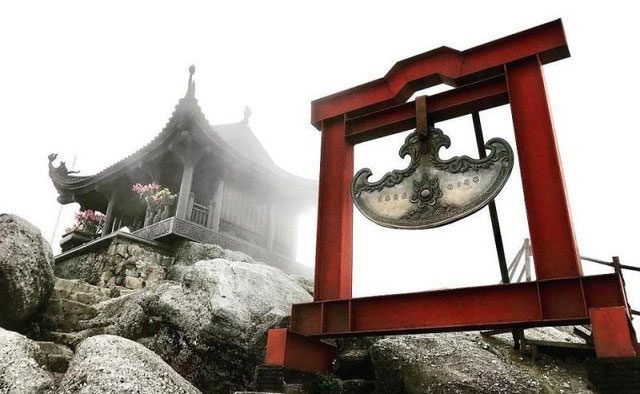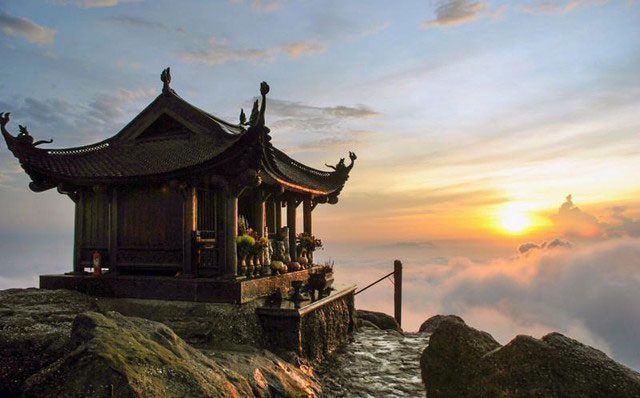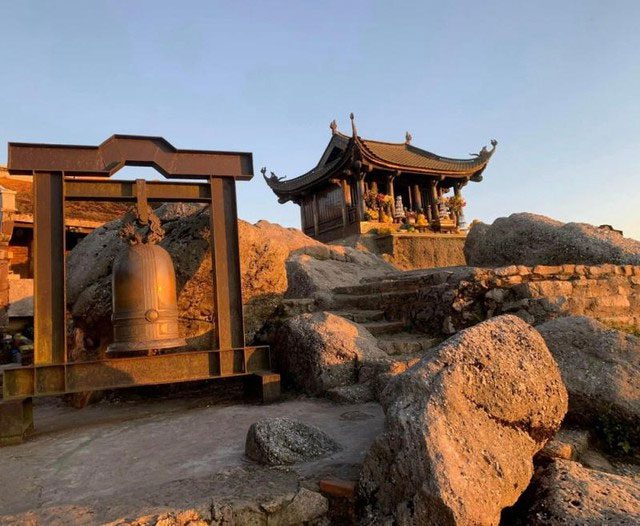This is considered a unique wonder of Vietnamese Buddhism in the early 21st century.
Where is Dong Pagoda? Who is worshipped there?
There is a couplet you might hear when visiting Yen Tu, which goes:
“A hundred years of accumulating virtue through cultivation.
Not yet returning to Yen Tu, still unwilling to cultivate.”
This is a very famous couplet when mentioning this sacred land of Vietnamese Buddhism.
Dong Pagoda, also known as Thien Truc Tu, is located at the peak of the Yen Tu mountain range, with an altitude of 1,068 meters above sea level, in Nam Mau village, Thuong Yen Cong commune, Uong Bi city, Quang Ninh province.
In the past, Yen Tu was called Bach Van Son (White Cloud Mountain) and was listed among the famous mountains. Yen Tu Pagoda was chosen by King Buddha Tran Nhan Tong as a place for meditation after abdicating the throne and establishing the Truc Lam Yen Tu Zen sect.

From below, you will see the pagoda surrounded by mist, resembling a fairyland. (Photo: MIA)
Dong Pagoda has a structure resembling the character Ding (丁), shaped like a blooming lotus flower. Inside the pagoda, there is a statue of Buddha Shakyamuni and three statues of the Three Founders of Truc Lam. The Shakyamuni statue is dressed in a robe, seated in meditation in the lotus position. The three founder statues are seated on lotus pedestals, decorated with lotus, chrysanthemum, and wave patterns: the central statue represents King Tran Nhan Tong, with the two sides representing the venerables Phap Loa and Huyen Quang.
Dong Pagoda Yen Tu is approximately 130 kilometers from Hanoi. With this distance, you can choose various means of transport to head to Yen Tu, such as buses or personal vehicles:
Traveling by personal vehicle (car, motorbike): Follow the Chuong Duong Bridge through Nguyen Van Cu, then head towards QL18 to reach Bac Ninh. From there, go straight until you reach Trinh Pagoda, then turn left and continue for about 10 kilometers to reach Yen Tu.
Traveling to the Yen Tu tourist area by bus: From Hanoi, you can take buses to Cam Pha, Uong Bi, or Ha Long to reach the spiritual tourism area of Yen Tu. When the bus reaches Trinh Pagoda on National Highway 18, you can get off. From there, take a bus to Yen Tu.

Dong Pagoda Yen Tu is about 130 km from Hanoi. (Photo: Google Maps)
The History of Dong Pagoda
Originally, Dong Pagoda was named Thien Truc Tu (Thien Truc Pagoda), named after the land of the Buddha Shakyamuni: “The land of Thien Truc.” The pagoda was cast in bronze, initially just a small shrine that one person could not fit into.
According to information from the newspaper Tri Thuc va Cuoc Song, based on the book Dai Nam Nhat Thong Chi, the pagoda was built by the wife of a Trinh lord. In the year Canh Than (1740), it was stolen by bandits, leaving only deep holes where the pillars were embedded in the rock. The book Viem Giao Trưng Co Ky states: “Dong Pagoda was built by the Trinh family, with a roof entirely covered in bronze tiles, casting bronze statues. By the reign of Canh Hung under the Le dynasty, the remnants of the pagoda still remain.”
In 1930, Mrs. Bui Thi My rebuilt Dong Pagoda using reinforced concrete on a square stone higher than a person’s head at the site of the old Dong Pagoda.
By 1993, Mr. Nguyen Son Nam, a Vietnamese expatriate in the U.S., along with overseas Buddhists, decided to cast a new pagoda designed in the shape of a “Dinh” resembling a blooming lotus flower, placed right beside the concrete Dong Pagoda built in the early 20th century.
In 2006, Venerable Thich Thanh Quyet (Thang Toa Thich Thanh Quyet) and the Project Management Board of Dong Pagoda presided over the groundbreaking ceremony for the pagoda based on the design by architect Tran Quoc Tuan. The pagoda was officially completed in 2007. The two old pagodas were transferred to the exhibition house of the heritage management board.
The Unique Architecture of Dong Pagoda
According to the newspaper Quan Doi Nhan Dan, Dong Pagoda weighs 60 tons, covering an area of 16.55 square meters. The tallest bronze pillar is over 3 meters high, while the shortest ones are 2.60 meters and 2.20 meters, with a total of 16 bronze pillars, and the diameter of the bronze pillars ranges from 20 cm to 30 cm.

This is the largest bronze pagoda in Asia. (Photo: MIA).
Dong Pagoda Yen Tu is renowned not only for its sacredness but also for its unique architecture. The pagoda’s location resembles a giant lotus flower. Each side of the stone resembles a blooming petal. Dong Pagoda is situated right in the center of the lotus pedestal. The four roof eaves of the pagoda are shaped like dragon heads, reflecting the architectural style of the Tran dynasty. The roof extends outward on all sides to form a porch. Below the walls are decorated with leaf patterns. In front of the porch, there are guardrails shaped like bamboo stalks.
The tiles of the pagoda are shaped like pointed shoes, with the wall panels, railings, cranes, couplets, and dragon reliefs all vividly cast. The altar used for placing the 4-ton bronze statue is made of heavy bricks weighing 13 kg.
Dong Pagoda is firmly placed on a concrete foundation (5m long x 4m wide). This base is supported by concrete pillars longer than 2 meters, cast together with the foundation and driven deep into the mountain.
How was the construction of Dong Pagoda carried out?
The entire construction of Dong Pagoda was cast using traditional manual methods by a group of artisans from the bronze casting village of Y Yen (Nam Dinh).
According to the newspaper Quan Doi Nhan Dan, the workers directly involved in assembling the bronze pagoda on the peak of Yen Tu mountain stated: “The entire frame of the pagoda, such as support pillars, beams, and rafters, was cast by the Y Yen-Nam Dinh bronze artisans at the foot of Yen Tu mountain. After that, we tested the assembly of the pagoda’s frame at the foot of the mountain, then disassembled it and used cables and pulleys to transfer all the bronze columns and beams from the foot of the mountain to the peak. Once there, we reassembled the pagoda frame according to the design blueprint.”

The interior of the pagoda is simply designed but still impressive due to its predominantly bronze furnishings. (Photo: MIA)
The newspaper Tien Phong further analyzes this process, stating that the construction workers created a flat area of about 20 m2 to serve as the foundation for the pagoda. The hard rock surface, weathered over many years, and the limited use of drilling machines made it common to break the rocks by hand.
The entire transportation route for Dong Pagoda is 3,500 meters towards an elevation of 1,068 meters above sea level. How could the pagoda’s components be moved from the ground to the mountain peak and reassembled? Various transportation methods, including land routes, cable systems, and even helicopters, were considered. Ultimately, the cable pulley system was deemed the most feasible option. Accordingly, the contractors installed support posts at 6 points along the route from Giai Oan Pagoda to Dong Pagoda, then set up a cable system to transport materials and cast details.
Bricks, sand, gravel, and cement for constructing items such as the dedication house, ceremonial yard, offering altar, foundation, and pagoda yard… were primarily transported by land. Local laborers familiar with the mountain paths had to carry materials from the foot of the mountain to the peak. During peak construction times, up to 80-90 hired workers would carry materials at a wage of 3,000 VND/kg, as reported by Thanh Tra.
After nearly 360 days of continuous construction, the record-breaking bronze pagoda was inaugurated on December 12, 2006 (lunar calendar).
Dong Pagoda currently holds several records in Vietnam and Asia:
- The largest bronze pagoda on a mountain peak in Asia in 2012
- The largest bronze pagoda recognized by the Vietnam Record Book Center
- The pagoda located at the highest altitude in Vietnam
- The pagoda dubbed the “newest wonder”
Strange story in An Giang: The monk’s body remains intact after 6 years of burial
The pagoda located on a divided mountain peak and the mysteries that perplex descendants


















































